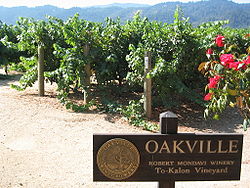| Wine region | |
 Napa Valley AVAs | |
| Type | American Viticultural Area |
|---|---|
| Year established | 1993 [1] |
| Country | United States |
| Part of | California, North Coast AVA, Napa County, Napa Valley AVA |
| Other regions in California, North Coast AVA, Napa County, Napa Valley AVA | Atlas Peak AVA, Calistoga AVA, Chiles Valley AVA, Crystal Springs of Napa Valley AVA, Diamond Mountain District AVA, Howell Mountain AVA, Los Carneros AVA, Mt. Veeder AVA, Coombsville AVA, Oak Knoll District of Napa Valley AVA, Rutherford AVA, Spring Mountain District AVA, St. Helena AVA, Stags Leap District AVA, Wild Horse Valley AVA, Yountville AVA |
| Soil conditions | well-drained gravel |
| Total area | 5,700 acres (9 sq mi) [2] |
| Size of planted vineyards | 5,000 acres (2,023 ha) [2] |
| Grapes produced | Cabernet Sauvignon, Merlot, Chardonnay |
Oakville is an American Viticultural Area (AVA) located in Napa County, California within the Napa Valley viticultural area centered around the town of Oakville. The wine appellation was established on July 2, 1993 as the nation's 122nd, the state's 70th and county's eighth AVA [3] by the Bureau of Alcohol, Tobacco and Firearms (ATF), Treasury after reviewing the petition submitted by the Rutherford and Oakville Appellation Committee, on behalf of local vineyard and winery operators, proposing a viticultural area in Napa County to be known as "Oakville." [4]
Contents
The Rutherford and Oakville Appellation Committee was composed of seven wineries and seven grape growers in the areas who petitioned both to be established which ATF ruled on the same day. The appellation extends over a flat expanse of well-drained gravel soil between the Vaca and Mayacamas Mountains. Oakville AVA is known for its success with Bordeaux varietals, which have produced wines of rich texture, firm tannins, and notes of mint and herbs. [2] The plant hardiness zone range is 9a to 9b. [5]
